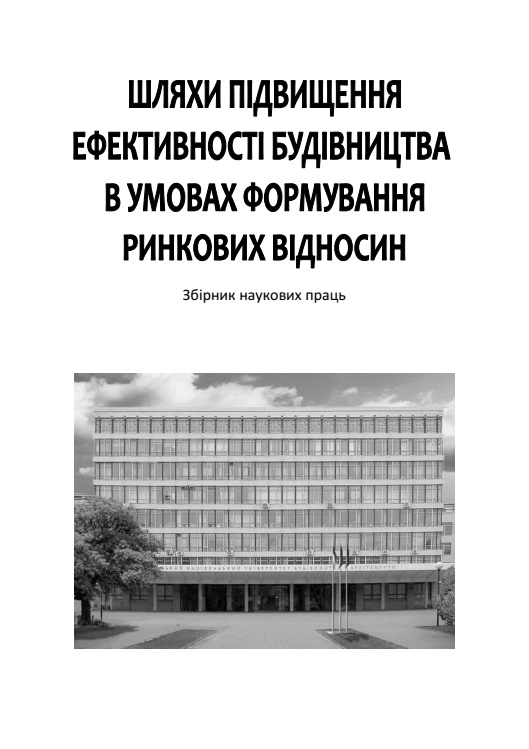Organizational-economic system of risk management of construction projects
DOI:
https://doi.org/10.32347/2707-501x.2019.40.77-85Keywords:
construction, management, project, risksAbstract
The article analyzes the issues of risk management of construction projects, in particular, the theoretical-empirical and organizational and applied structuring of elements of the risk management system of construction projects is elaborated: the purpose, functions, tasks, principles, methodological support, methods of estimating the system.
In the context of the formation of an effective risk management model for construction projects, it is proposed to implement an integrative-convergence approach, identifying it as a research methodology that uses synergy of system, target, functional, process, situational, cybernetic, reflexive approaches in order to prevent the risks of implementing construction projects.
References
Illiashenko, S. M. (2004) Upravlinnia ekolohichnymy ryzykamy innovatsij: monohrafiia /V. V. Bozhkova. – Sumy: VTD „Universytets'ka knyha”. – 214 p.
Kulikov, P. M (2017). Upravlinnia enerhozberezhenniam nabudivel'nykh pidpryiemstvakh: teoriia, metodolohiia, praktyka : monohr. /M. M. Klymchuk. – Ivano-Frankivs'k, vyd-vo «Foliant». – 344 p.
Najt, F and Kh. Rysk (2003), neopredelennost' y prybyl' / per. s anhl. - M.: Delo. - 360 p.
Ratushniak, O.H (2010). Upravlinnia ekoloho-ekonomichnymy ryzykamy innovatsijnykh enerhozberihaiuchykh proektiv u budivnytstvi / Upravlinnia proektamy ta rozvytok vyrobnytstva: Zb.nauk.pr. - Luhans'k: vyd-vo SNU im. V.Dalia, - № 3(35). – p
Semenova, K. D (2013). Vyiavlennia ta otsinka ryzykiv iak element zabezpechennia konkurentospromozhnosti pidpryiemstva /K. I. Tarasova // Konkurentospromozhnist' pidpryiemstva : otsinka rivnia ta napriamy pidvyschennia : [monohrafiia / za zah. red. O. H. Yankovoho]. – Odesa : Atlant, – p. 337-352
Froot, K.A. A (1994) Framework for risk management /D. Shaferstein, J.K. Stein // Harvard Business Review. – R. 25.
Kaplan, R.S (2004). Managing risks: a new framework / R.S. Kaplan, A. Mikes // Harvard Business Review. – 2012. – June. – R. 90. Upravlinnia ekolohichnymy ryzykamy innovatsij: monohrafiia /V. V. Bozhkova. – Sumy: VTD „Universytets'ka knyha”. – 214 p.
Bielienkova, O.Yu. (2007), “Systema metodiv upravlinnia rozvytkom budivel'noho pidpryiemstva”, Ekonomika ta derzhava, 2007, vol.9, pp. 38-42.
Nyschev, S.K. (2010) , “ Vyzhyvanye predpryiatyia stroytel'noj otrasly v sytuatsyy destruktsyy rynka 2009 hoda – praktycheskye rekomendatsyy”. URL: http://www.gdeetotdom.ru/ analytics/building/1813396/.
Tytok, V.V. (2013), “Formuvannia modeli zhytlovoho budivnytstva v misti”, Shliakhy pidvyschennia efektyvnosti budivnytstva v umovakh formuvannia rynkovykh vidnosyn, vol.30, pp. 90-99.
Kravchenko, O. S. (2013), “Ryzykostijkist' iak peredumova efektyvnoho rozvytku pidpryiemstva: indykatory vyznachennia ta metodyka diahnostyky”, Visnyk Donets'koho natsional'noho universytetu ekonomiky i torhivli im. Mykhajla Tuhan-Baranovs'koho. Ekonomichni nauky, vol. 4. URL: http://nbuv.gov.ua/UJRN/vdnuete_2013_4_11
Vitlins'kyj, V.V. and Vercheno, P.I. (2000), Analiz, modeliuvannia ta upravlinnia ekonomichnym ryzykom. K.: KNEU, pp. 292.
Downloads
How to Cite
Issue
Section
License

This work is licensed under a Creative Commons Attribution 4.0 International License.
Authors who publish with this journal agree to the following terms:
- Authors retain copyright and grant the journal right of first publication with the work simultaneously licensed under a Creative Commons Attribution License that allows others to share the work with an acknowledgement of the work's authorship and initial publication in this journal.
- Authors are able to enter into separate, additional contractual arrangements for the non-exclusive distribution of the journal's published version of the work (e.g., post it to an institutional repository or publish it in a book), with an acknowledgement of its initial publication in this journal.
- Authors are permitted and encouraged to post their work online (e.g., in institutional repositories or on their website) prior to and during the submission process, as it can lead to productive exchanges, as well as earlier and greater citation of published work (See The Effect of Open Access).

